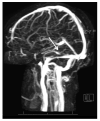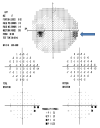Idiopathic intracranial hypertension
- PMID: 20637991
- PMCID: PMC2908600
- DOI: 10.1016/j.ncl.2010.03.003
Idiopathic intracranial hypertension
Abstract
Idiopathic intracranial hypertension ((IIH) is characterized by increased cerebrospinal fluid pressure of unknown cause. It is predominantly a disease of women in the childbearing years. Although the cause of IIH remains obscure, it has become clear that loss of visual function is common and patients may progress to blindness if untreated. Diagnosis should adhere to the modified Dandy criteria and other causes of intracranial hypertension sought. IIH patient management should include serial perimetry and optic disc grading or photography. The proper therapy can then be selected and visual loss prevented or reversed. Although there are no evidence-based data to guide therapy, there is an ongoing randomized double-blind controlled treatment trial of IIH investigating diet and medical therapy.
Copyright 2010 Elsevier Inc. All rights reserved.
Figures












References
-
- Corbett JJ, Savino PJ, Thompson HS, et al. Visual loss in pseudotumor cerebri. Follow-up of 57 patients from five to 41 years and a profile of 14 patients with permanent severe visual loss. Arch Neurol. 1982;39:461–474. - PubMed
-
- Wall M, Hart WM, Jr., Burde RM. Visual field defects in idiopathic intracranial hypertension (pseudotumor cerebri) Am J Ophthalmol. 1983;96:654–669. - PubMed
-
- Corbett JJ, Mehta MP. Cerebrospinal fluid pressure in normal obese subjects and patients with pseudotumor cerebri. Neurology. 1983;33:1386–1388. - PubMed
-
- Smith JL. Whence pseudotumor cerebri? J Clin Neuro-ophthalmol. 1985;5:55–56. - PubMed
-
- Durcan FJ, Corbett JJ, Wall M. The incidence of pseudotumor cerebri. Population studies in Iowa and Louisiana. Arch Neurol. 1988;45:875–877. - PubMed
Publication types
MeSH terms
Grants and funding
LinkOut - more resources
Full Text Sources
Medical

